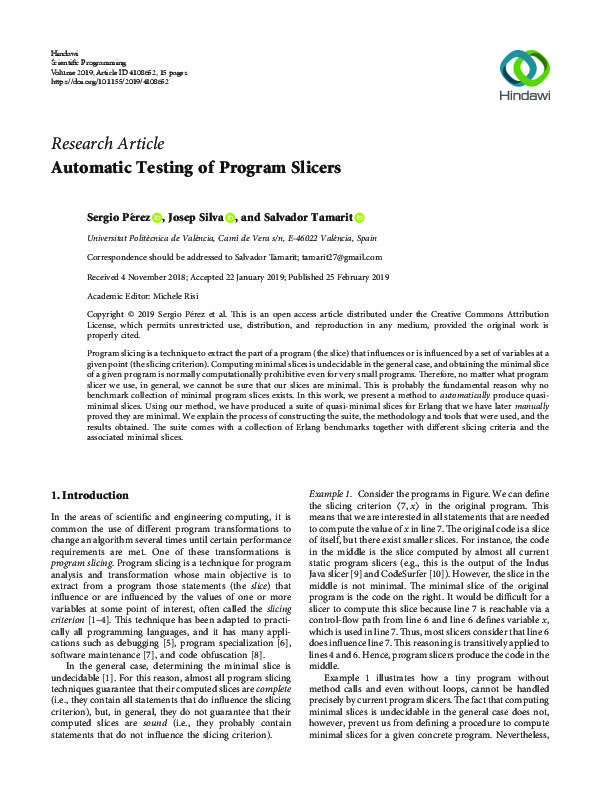JavaScript is disabled for your browser. Some features of this site may not work without it.
Buscar en RiuNet
Listar
Mi cuenta
Estadísticas
Ayuda RiuNet
Admin. UPV
Automatic Testing of Program Slicers
Mostrar el registro sencillo del ítem
Ficheros en el ítem
| dc.contributor.author | Pérez-Rubio, Sergio
|
es_ES |
| dc.contributor.author | Silva, Josep
|
es_ES |
| dc.contributor.author | Tamarit Muñoz, Salvador
|
es_ES |
| dc.date.accessioned | 2020-04-17T12:51:41Z | |
| dc.date.available | 2020-04-17T12:51:41Z | |
| dc.date.issued | 2019 | es_ES |
| dc.identifier.issn | 1058-9244 | es_ES |
| dc.identifier.uri | http://hdl.handle.net/10251/140958 | |
| dc.description.abstract | [EN] Program slicing is a technique to extract the part of a program (the slice) that influences or is influenced by a set of variables at a given point (the slicing criterion). Computing minimal slices is undecidable in the general case, and obtaining the minimal slice of a given program is normally computationally prohibitive even for very small programs. Therefore, no matter what program slicer we use, in general, we cannot be sure that our slices are minimal. This is probably the fundamental reason why no benchmark collection of minimal program slices exists. In this work, we present a method to automatically produce quasi-minimal slices. Using our method, we have produced a suite of quasi-minimal slices for Erlang that we have later manually proved they are minimal. We explain the process of constructing the suite, the methodology and tools that were used, and the results obtained. The suite comes with a collection of Erlang benchmarks together with different slicing criteria and the associated minimal slices. | es_ES |
| dc.description.sponsorship | This work has been partially supported by MINECO/AEI/FEDER (EU) under grant TIN2016-76843-C4-1-R and by the Generalitat Valenciana under grant PROMETEO-II/2015/013 (SmartLogic). | es_ES |
| dc.language | Inglés | es_ES |
| dc.publisher | Hindawi Limited | es_ES |
| dc.relation.ispartof | Scientific Programming | es_ES |
| dc.rights | Reconocimiento (by) | es_ES |
| dc.subject.classification | LENGUAJES Y SISTEMAS INFORMATICOS | es_ES |
| dc.subject.classification | CIENCIAS DE LA COMPUTACION E INTELIGENCIA ARTIFICIAL | es_ES |
| dc.title | Automatic Testing of Program Slicers | es_ES |
| dc.type | Artículo | es_ES |
| dc.identifier.doi | 10.1155/2019/4108652 | es_ES |
| dc.relation.projectID | info:eu-repo/grantAgreement/GVA//PROMETEOII%2F2015%2F013/ES/SmartLogic: Logic Technologies for Software Security and Performance/ | es_ES |
| dc.relation.projectID | info:eu-repo/grantAgreement/MINECO//TIN2016-76843-C4-1-R/ES/METODOS RIGUROSOS PARA EL INTERNET DEL FUTURO/ | es_ES |
| dc.rights.accessRights | Abierto | es_ES |
| dc.contributor.affiliation | Universitat Politècnica de València. Departamento de Sistemas Informáticos y Computación - Departament de Sistemes Informàtics i Computació | es_ES |
| dc.description.bibliographicCitation | Pérez-Rubio, S.; Silva, J.; Tamarit Muñoz, S. (2019). Automatic Testing of Program Slicers. Scientific Programming. 4108652:1-15. https://doi.org/10.1155/2019/4108652 | es_ES |
| dc.description.accrualMethod | S | es_ES |
| dc.relation.publisherversion | https://doi.org/10.1155/2019/4108652 | es_ES |
| dc.description.upvformatpinicio | 1 | es_ES |
| dc.description.upvformatpfin | 15 | es_ES |
| dc.type.version | info:eu-repo/semantics/publishedVersion | es_ES |
| dc.description.volume | 4108652 | es_ES |
| dc.relation.pasarela | S\379110 | es_ES |
| dc.contributor.funder | Generalitat Valenciana | es_ES |
| dc.contributor.funder | Ministerio de Economía y Competitividad | es_ES |
| dc.description.references | Binkley, D. W., & Gallagher, K. B. (1996). Program Slicing. Advances in Computers, 1-50. doi:10.1016/s0065-2458(08)60641-5 | es_ES |
| dc.description.references | Silva, J. (2012). A vocabulary of program slicing-based techniques. ACM Computing Surveys, 44(3), 1-41. doi:10.1145/2187671.2187674 | es_ES |
| dc.description.references | DeMillo, R. A., Pan, H., & Spafford, E. H. (1996). Critical slicing for software fault localization. ACM SIGSOFT Software Engineering Notes, 21(3), 121-134. doi:10.1145/226295.226310 | es_ES |
| dc.description.references | Hajnal, Á., & Forgács, I. (2011). A demand-driven approach to slicing legacy COBOL systems. Journal of Software: Evolution and Process, 24(1), 67-82. doi:10.1002/smr.533 | es_ES |
| dc.description.references | Anderson, P., Reps, T., & Teitelbaum, T. (2003). Design and implementation of a fine-grained software inspection tool. IEEE Transactions on Software Engineering, 29(8), 721-733. doi:10.1109/tse.2003.1223646 | es_ES |
| dc.description.references | Zeller, A., & Hildebrandt, R. (2002). Simplifying and isolating failure-inducing input. IEEE Transactions on Software Engineering, 28(2), 183-200. doi:10.1109/32.988498 | es_ES |
| dc.description.references | Llorens, M., Oliver, J., Silva, J., & Tamarit, S. (2016). Dynamic slicing of concurrent specification languages. Parallel Computing, 53, 1-22. doi:10.1016/j.parco.2016.01.006 | es_ES |
| dc.description.references | Binkley, D., Gold, N., & Harman, M. (2007). An empirical study of static program slice size. ACM Transactions on Software Engineering and Methodology, 16(2), 8. doi:10.1145/1217295.1217297 | es_ES |
| dc.description.references | Binkley, D. (1993). Precise executable interprocedural slices. ACM Letters on Programming Languages and Systems, 2(1-4), 31-45. doi:10.1145/176454.176473 | es_ES |
| dc.description.references | Tai, K.-C. (1979). The Tree-to-Tree Correction Problem. Journal of the ACM, 26(3), 422-433. doi:10.1145/322139.322143 | es_ES |








